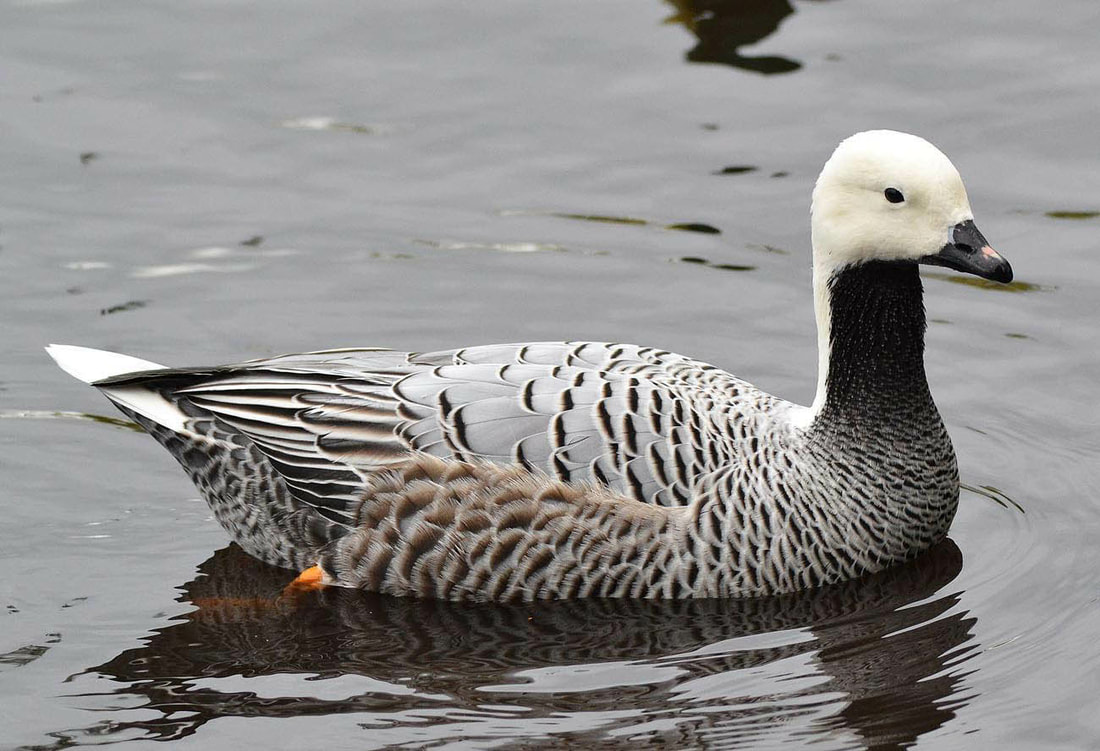Emperor Goose (Anser canagicus)
Physical Description: Emperor Geese are small stocky birds. They have dark barred plumage on their bodies with white tail feathers. They have white heads, a short pink bill, and orange legs. During breeding season, some adults will have orange-colored heads and necks rather than whit due to iron oxide concentration in tidal areas.
The Emperor Goose is approximately 2 to 3 feet long and weighs between 4 and 6 pounds with the female being slightly smaller than the male. They have a four-foot wingspan.
Their vision is excellent, however when seeking mollusks in muddy water they rely on their sense of touch. Emperor Geese fly lower than other species of geese, but they have faster wing beats. When threatened on land, they usually run toward water and swim to a safe distance.
Habitat: They typically nest in open sites in the arctic tundra during the mating season, either near inland lakes, coastal lagoons, or freshwater pools. In winter, they are mainly found on ice-free coasts.
Range: Emperor Geese have a range that centers on the North Pacific Ocean in the Bering Sea. They breed in sub-Arctic and Arctic Alaska, Canada, and along Russia's northeastern coast.
Diet: Emperor Geese are omnivores however the bulk of their diet is plant matter such as grasses, berries, seaweed, and algae. They will also eat mollusks and crustaceans during the winter spent on the coast.
Lifespan: The live 12 years in the wild and up to 25 in human care.
Social Structure: They gather in small family groups, but during breeding and molting seasons they form larger flocks, with the non-breeding geese forming a separate flock.
Status: Near Threatened1
Other: They are among the avian species that reside farthest north in the world!
1 https://www.iucnredlist.org/species/22679919/92834737
The Emperor Goose is approximately 2 to 3 feet long and weighs between 4 and 6 pounds with the female being slightly smaller than the male. They have a four-foot wingspan.
Their vision is excellent, however when seeking mollusks in muddy water they rely on their sense of touch. Emperor Geese fly lower than other species of geese, but they have faster wing beats. When threatened on land, they usually run toward water and swim to a safe distance.
Habitat: They typically nest in open sites in the arctic tundra during the mating season, either near inland lakes, coastal lagoons, or freshwater pools. In winter, they are mainly found on ice-free coasts.
Range: Emperor Geese have a range that centers on the North Pacific Ocean in the Bering Sea. They breed in sub-Arctic and Arctic Alaska, Canada, and along Russia's northeastern coast.
Diet: Emperor Geese are omnivores however the bulk of their diet is plant matter such as grasses, berries, seaweed, and algae. They will also eat mollusks and crustaceans during the winter spent on the coast.
Lifespan: The live 12 years in the wild and up to 25 in human care.
Social Structure: They gather in small family groups, but during breeding and molting seasons they form larger flocks, with the non-breeding geese forming a separate flock.
Status: Near Threatened1
Other: They are among the avian species that reside farthest north in the world!
1 https://www.iucnredlist.org/species/22679919/92834737







